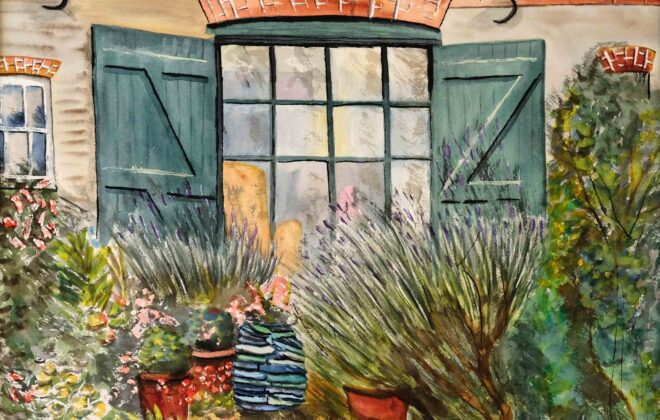A sideways look at the magic of watercolour
Thoughts of a striving painter – Part 1
by Alan Noyes
Whatever jottings and ramblings I put down here can either be attributed to ideas and advice I have gleaned over time from numerous books in my studio, (How to Paint like Turner by Tate Publishing in particular), or from studying the works of other artists or to the accidents and magic of watercolour that occurs whilst messing about with the medium. And if messing about equates to having fun then that is what it should be – fun.
To my mind, watercolour is the greatest and most perfect medium of all, it is certainly one of the oldest. Cave paintings in central Europe show silhouettes apparently applied by spraying a mouthful of raw sienna solution over a human hand. I am not advocating that – but whatever turns you on! Watercolour doesn’t smell much, it doesn’t stick to everything, doesn’t cover everything with dust and if (like me), you are untidy, doesn’t take up a lot of room and is easy to carry about – the perfect medium.
My preferences aside, I suppose the first question is “what is watercolour” and, at a very basic scientific and mundane level, the colour part could be described as a mixture of natural or man made materials held together with a binding agent such as gum arabic, awaiting the addition of water to provide a solution which can be applied to a surface, usually by brush, resulting in a dried translucent film allowing light to reflect from the supporting surface – and how boring is that – a definition designed to send you off to learn bee keeping or macramé.
Where does the magic happen?
But at the ‘awaiting the addition of water’ stage is just where we come in. We are the magicians who conjure up the magic in what is certainly a very magical process.
Just by the addition of water we can release the magic of watercolour. Those beautiful flowing and swirling tones, those misty, mystic washes that combine to form a masterpiece of brilliant, iridescent and transparent colour.
Simple isn’t it – just add water.
Those of us who practice this aggravating art of watercolour know that simple, it is not.
Watercolour is a headstrong mistress with a very definite mind of her own and success as a painter in this medium relies on recognising that fact and practice, practice, practice.
PRACTICE – to understand the limitations of the medium
PRACTICE – to understand its boundless possibilities and finally,
PRACTICE – to put the two together in a successful finished work – but the real secret ingredient to success comes when you realise that watercolour knows what it is doing almost by itself. You are but an aid to the final result, a mere manual labourer and the more you try to interfere in the process the more stubborn the mistress becomes to a point where she just gives up and turns to mud.
Try a little magic watercolour experiment
- Fill a jam jar with clean water.
- Mix, in separate pots, fairly strong solutions of the three primaries, red, yellow and blue.
- Using a full brush or dropper, drop the three colours individually into the water and watch the result.
Undisturbed the three pigments retain their individuality, tumbling about each other.
Now give the water a quick stir and see what happens. Magic to mud in a second.
This is an extreme illustration of what happens when we overwork a watercolour, scrubbing and pushing at the paper, the translucence and brilliance of the pigment disappear and we begin to lose heart – wash it out, tear it up, start again.
The real magic of watercolour
But how lucky are we, we 21st century watercolourists. Bear a thought for those who came before – Turner, Constable, Cotman, the founders of The Norwich School and their predecessors. Not for them the on line art store, the local art shop, paint in tubes. Although William Reeves produced small hard cakes of watercolour towards the end of the 18th century, most artists ground their own pigments from coarse materials prepared by colourmen. So the next time, when things are not going right or you run out of blue, don’t chuck your brushes in the air – just be thankful you don’t have to reach for your muller and grind your own.
Search by category
Blog archive
- February 2023
- October 2022
- June 2022
- April 2022
- January 2022
- October 2021
- July 2021
- April 2021
- March 2021
- February 2021
- January 2021
- October 2020
- September 2020
- August 2020
- July 2020
- June 2020
- May 2020
- April 2020
- March 2020
- February 2020
- January 2020
- December 2019
- October 2019
- July 2019
- April 2019
- March 2019
- January 2019
- December 2018
- April 2018



